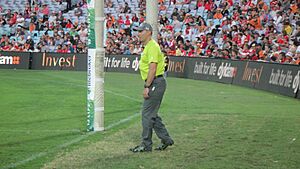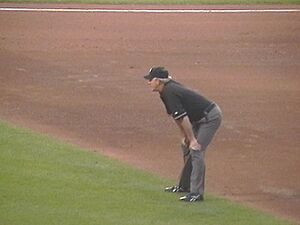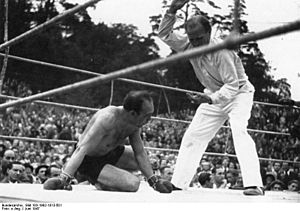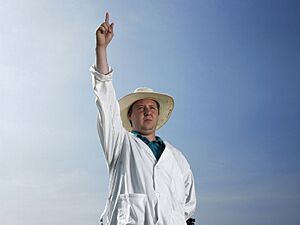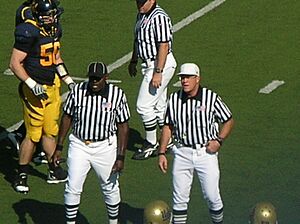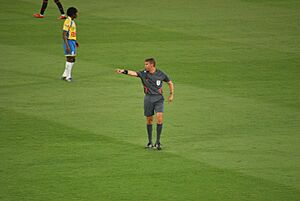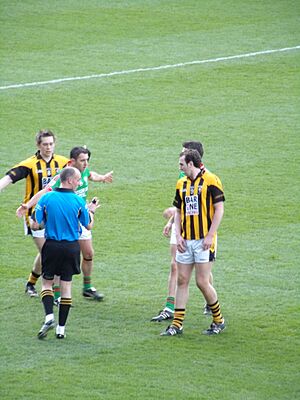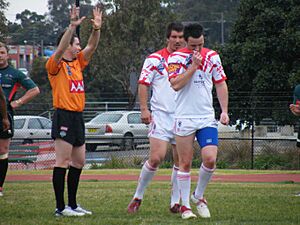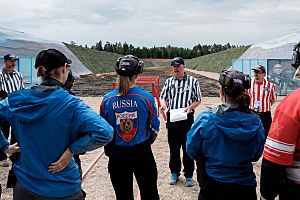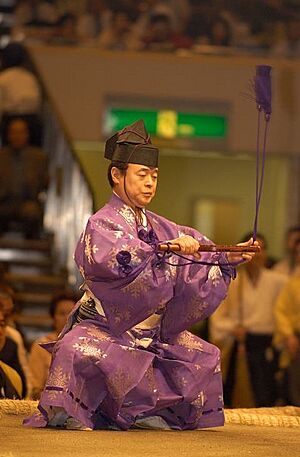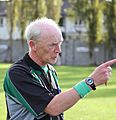Referee facts for kids
A referee, often called a ref, is a very important person in many sports. They are in charge of the game and make sure everyone follows the rules. Referees need to be fair and neutral, meaning they don't favor one team over another. They make quick decisions during the game, like when to give a yellow card or even remove a player from the game if they break the rules badly.
Referees can have different names depending on the sport. You might hear them called an official, umpire, judge, linesman, or even a timekeeper.
Contents
- Where the Name "Referee" Came From
- Referees in Different Sports
- Australian Rules Football
- Bandy
- Baseball and Softball
- Basketball
- Boxing
- Cricket
- Cycling
- Field Hockey
- Figure Skating
- Floorball
- American and Canadian Football
- Association Football (Soccer)
- Gaelic Football
- Golf
- Handball
- Hurling
- Ice Hockey
- Korfball
- Lacrosse
- Lawn Bowls
- Mixed Martial Arts (MMA)
- Motorsport
- Netball
- Roller Derby
- Rowing
- Rugby League
- Rugby Union
- Sailing
- Shooting
- Sumo
- Tennis
- Underwater Hockey
- Volleyball
- Amateur Wrestling
- Professional Wrestling
- Other Uses of "Umpire"
- What Referees Wear
- Images for kids
- See also
Where the Name "Referee" Came From
The word "referee" first came from association football, which is also known as soccer. Long ago, the team captains would talk to each other to solve any problems during a game. Later, they started using an umpire for this job. Each team would bring their own umpire, who might be a bit biased.
Then, a third official was added: the referee. This person was "neutral," meaning they didn't support either team. If the two umpires couldn't agree, they would "refer to" the referee for the final decision. The referee didn't actually stand on the field until 1891. That's when the umpires became linesmen, who are now called assistant referees.
Referees in Different Sports
Referees play a key role in almost every sport, but their exact duties and titles can change. Here are some examples:
Australian Rules Football
In Australian rules football, officials are called umpires. There are usually one to three field umpires, two to four boundary umpires, and two goal umpires. Each has a specific area to watch.
Bandy
A bandy game is controlled by a referee. Their decisions are final. Sometimes, one or two assistant referees help them.
Baseball and Softball
In baseball and softball, there's usually a head umpire, also known as the plate umpire. This umpire stands behind home plate and calls balls and strikes. Other field umpires help by making calls at the bases or in the outfield. The head umpire makes the final decision if there's a disagreement.
Basketball
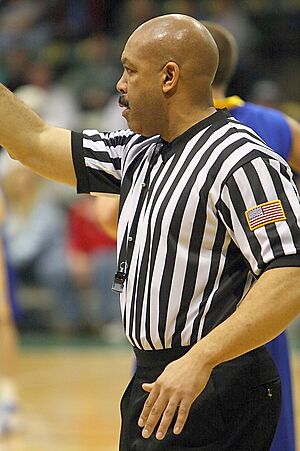
In international basketball and college basketball, the main official is called the referee. They are helped by one or two umpires. In the National Basketball Association (NBA), the main official is called the crew chief, and the others are referees. All officials in basketball have similar power.
Boxing
In boxing, the referee makes sure the rules are followed during a fight. They give instructions to the fighters, start and stop counts when a boxer is down, and can stop a fight if a boxer is in danger.
Cricket
In cricket, an off-field match referee handles player behavior and penalties for breaking the rules. On the field, two umpires make decisions about the game itself. A third umpire off the field can help with some tricky decisions.
Cycling
In competitive cycling, an official is called a commissaire.
Field Hockey
An umpire in field hockey makes decisions on the field based on the game's laws. Two umpires control each match, often helping and correcting each other.
Figure Skating
A referee in figure skating sits with the judges and manages the whole event. They represent the International Skating Union at big international events.
Floorball
Two referees with equal power control a floorball game.
American and Canadian Football
In American football and Canadian football, the referee supervises the game and has the final say on all rulings. Up to six other officials help on the field. Each official has a specific title and job, like head linesman or umpire.
Association Football (Soccer)
A soccer match is controlled by a referee. The Laws of the Game give them "full authority to enforce the Laws of the Game." The referee is often helped by two assistant referees and sometimes a fourth official. In some games, two extra assistant referees stand near the goal posts to watch for fouls and whether the ball crosses the goal line.
Gaelic Football
Gaelic football usually has seven officials. A main referee follows the play and makes final decisions on fouls and cards. Two linesmen help by deciding who gets the ball when it goes out of bounds and can tell the referee about off-the-ball events. Two umpires at each end of the field raise flags for points or goals. They can also advise the referee. Sometimes, technology like 'Hawk-eye' is used if officials are unsure about a score.
Golf
Golf is often played without referees. However, a golf referee must stay alert during matches and make sure the rules of golf are followed.
Handball
Team handball games are controlled by two referees with equal power. A timekeeper and a scorekeeper assist them.
Hurling
Hurling usually has seven officials, similar to Gaelic football. A main referee makes decisions on fouls and cards. Two linesmen help with out-of-play calls and off-the-ball incidents. Two umpires at each goal raise flags for points or goals. An eighth official, the "Sideline Official," handles substitutions and additional time in important matches. Hawk-Eye technology can also be used for scoring decisions.
Ice Hockey
Ice hockey games are controlled by on-ice referees, who are usually helped by on-ice linesmen. The number of officials can vary. Some leagues now call linesmen "assistant referees." Off-ice officials also help with specific jobs like keeping score or tracking penalties.
Korfball
In korfball, the referee controls the game, enforces rules, and deals with bad behavior. An assistant referee helps by calling out-of-bounds balls and fouls. A timekeeper and scorer may also assist.
Lacrosse
A lacrosse match is controlled by two, three, or sometimes four on-field officials. The Referee always has the final decision. In important games, a Chief Bench Official might also be used to oversee the bench area.
Lawn Bowls
A lawn bowls match is overseen by a bowls umpire or technical official. In games with single players, a marker helps direct play and answers questions about the bowls' positions.
Mixed Martial Arts (MMA)
In mixed martial arts (MMA), a referee enforces the rules. They can give warnings or disqualify fighters. The referee also stops fights to protect a fighter's health, especially if they can't defend themselves. They make sure submissions are released after a tapout. The main job of an MMA referee is to keep the fighters safe.
Motorsport
In motorsport, race control manages the start, running, and timing of the race. Teams of marshals, led by an observer, are at different parts of the circuit. They report incidents and technical problems during the race.
Netball
In Netball, two umpires with good knowledge of the rules control the match. Two timekeepers and two scorekeepers also help by telling the umpires and players the time remaining and the scores.
Roller Derby
Roller derby games are controlled by a team of up to seven skating referees. The head referee oversees the whole game and has the final say. Inside pack referees follow the main group of skaters and give penalties. Two jammer referees follow the point-scoring players. Other referees and non-skating officials help with scoring, penalties, and making sure players wear safety gear.
Rowing
In a regatta (a rowing race), an umpire is the official on the water. They make sure racing rules are followed and that everyone is safe. The umpire starts the race and follows it to the end. Judges on the waterside decide the finish order of the crews.
Rugby League
Rugby league games are controlled by an on-field referee, helped by two touch judges. Sometimes, a video referee is used for televised games. Players cannot argue with the referee or touch judges, but captains can discuss calls. In some leagues, like Australia's National Rugby League, criticizing officials publicly can lead to fines. Some leagues are trying a two-referee system, where one referee controls the play and the other assists.
Touch Football
Touch football (or "touch") has a unique referee system. There's an on-field referee and referees on each sideline. These referees can swap places during the game, similar to players. This happens when the play moves close to the sideline or after scores and penalties. Touch referees often wear metal badges showing their official level.
Rugby Union
Rugby union games are controlled by an on-field referee, helped by two Assistant Referees (ARs). In televised games, a Television Match Official (TMO) might also be used. Players cannot argue with the referee or ARs, but captains can discuss calls.
Sailing
Referees are not always present during sailing races. Decisions are usually made by a special committee after the race. However, in some types of racing, an "umpire" is on the water to directly enforce the Racing Rules of Sailing. An umpire is also used to check if sailors are using their bodies too much to make the boat go faster.
Shooting
In practical shooting competitions, Range Officials act as referees. The International Range Officers Association trains and certifies these officials to make sure matches are safe and fair. A Range Officer (RO) gives commands and follows the shooter. A Chief Range Officer (CRO) oversees the RO. The Range Master (RM) has overall authority for all officials in the match. If a shooter disagrees with a call, they can challenge it to the CRO, then the RM, and finally to an Arbitration Committee. However, safety calls cannot be challenged.
Sumo
A sumo match is watched over by a referee (行司, gyōji) in the ring and five judges (勝負審判, shōbu shimpan) around the ring. They all wear traditional Japanese clothes. The referee manages the rituals and the fight, deciding the winner and the winning technique. If a judge disagrees, all the judges talk to decide the winner. If a top-ranked referee's decision is overturned, they are expected to offer their resignation, but it's usually not accepted.
Tennis
In tennis, an umpire is on the court, while a referee is an official who is off the court.
Underwater Hockey
An Octopush or underwater hockey match is controlled by two or three water referees in the pool, a chief referee on deck, and at least one timekeeper and one scorekeeper.
Volleyball
A volleyball match is controlled by a first referee, who stands on a platform to see over the net. A second referee helps at floor level on the opposite side of the net. They are sometimes called the "up referee" and "down referee." The first referee watches actions with the ball, while the second referee watches for errors by the defending team, like touching the net.
Amateur Wrestling
In international amateur wrestling, three officials are used: a referee on the mat, and a judge and a mat chairman who sit and watch. Collegiate wrestling uses one referee or a head referee and an assistant.
Professional Wrestling
In professional wrestling, the referee's job looks like that of referees in boxing. However, in reality, referees are part of the show. They help make sure the match goes as planned and communicate with the wrestlers and officials backstage.
Other Uses of "Umpire"
Military
In a military exercise, an umpire (or observer) is an officer who watches the training. They don't give orders to the soldiers but observe their actions and give feedback later.
Role-playing Games
A gamemaster acts like a referee in a multiplayer role-playing game. They organize the game, explain the rules, settle disagreements, and lead the story.
What Referees Wear
Referees usually wear special clothes to look different from the players. These uniforms can be very recognizable. For example, soccer referees traditionally wear black, and referees in many North American sports wear black and white stripes. This is why they are sometimes called "the man in black" or "zebra." Sometimes, referees also wear bright, reflective shirts.
Images for kids
See also
 In Spanish: Árbitro (deporte) para niños
In Spanish: Árbitro (deporte) para niños


